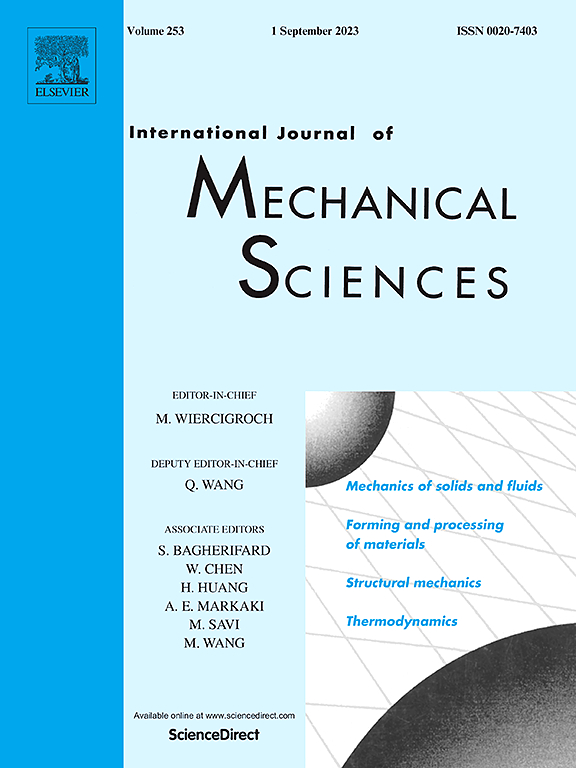Peridynamics model for bi-material interfaces incorporating contact friction effects
IF 9.4
1区 工程技术
Q1 ENGINEERING, MECHANICAL
International Journal of Mechanical Sciences
Pub Date : 2025-06-07
DOI:10.1016/j.ijmecsci.2025.110476
引用次数: 0
Abstract
Interface mechanical behavior significantly affects the structural integrity of composites and the reliability of engineering systems, with contact friction being a key contributor to interface failure. To investigate the failure mechanisms of material interfaces, this study develops a coupled bonding-contact friction peridynamics (PD) interface model. The bond-based PD is employed to describe the bonding and debonding processes. For characterizing contact friction, a three-dimensional nonlocal contact friction model is proposed to capture the friction behavior following debonding. The model incorporates long-range forces to account for spatially distributed contact effects, enabling accurate representation of interface behavior during both sticking and sliding contact friction stages. The contact friction model is verified through a two-block sliding model and Brazilian splitting experiments. Results show that the PD simulations exhibit close agreement with the finite element method (FEM) and experimental results. Combined with the classical microbond test, the applicability of the proposed model across different scales in the entire interface failure process is confirmed. Accounting for friction reduces the error in simulating peak pull-out force from 20.8 % to 1.3 %. In addition, a steel rod-cement interface debonding experimental model is designed. By comparing simulation results with experimental data, the error in predicting the peak load is reduced from 12.9 % to 6 % when friction is included. Furthermore, including friction enables accurate representation of the bonding and friction evolution during interface failure. This study provides an effective method for characterizing bonding and friction mechanisms during interface failure, with potential engineering application value.

结合接触摩擦效应的双材料界面周动力模型
界面力学行为显著影响复合材料的结构完整性和工程系统的可靠性,接触摩擦是界面破坏的关键因素。为了研究材料界面的破坏机制,本研究建立了一个结合-接触摩擦周动力学(PD)耦合界面模型。基于键的PD用于描述键合和脱键过程。为了表征接触摩擦,提出了一个三维非局部接触摩擦模型来捕捉脱粘后的摩擦行为。该模型结合了远程力来解释空间分布的接触效应,从而能够准确地表示粘着和滑动接触摩擦阶段的界面行为。通过两块滑动模型和巴西劈裂实验对接触摩擦模型进行了验证。结果表明,PD模拟结果与有限元方法和实验结果吻合较好。结合经典的微键试验,验证了该模型在不同尺度下对整个界面破坏过程的适用性。考虑摩擦使模拟峰值拔出力的误差从20.8%降低到1.3%。此外,设计了钢条-水泥界面脱粘试验模型。将仿真结果与实验数据进行比较,当考虑摩擦时,预测峰值载荷的误差从12.9%降低到6%。此外,包括摩擦可以准确地表示界面破坏过程中的键合和摩擦演变。该研究为表征界面破坏过程中的粘结和摩擦机制提供了有效的方法,具有潜在的工程应用价值。
本文章由计算机程序翻译,如有差异,请以英文原文为准。
求助全文
约1分钟内获得全文
求助全文
来源期刊

International Journal of Mechanical Sciences
工程技术-工程:机械
CiteScore
12.80
自引率
17.80%
发文量
769
审稿时长
19 days
期刊介绍:
The International Journal of Mechanical Sciences (IJMS) serves as a global platform for the publication and dissemination of original research that contributes to a deeper scientific understanding of the fundamental disciplines within mechanical, civil, and material engineering.
The primary focus of IJMS is to showcase innovative and ground-breaking work that utilizes analytical and computational modeling techniques, such as Finite Element Method (FEM), Boundary Element Method (BEM), and mesh-free methods, among others. These modeling methods are applied to diverse fields including rigid-body mechanics (e.g., dynamics, vibration, stability), structural mechanics, metal forming, advanced materials (e.g., metals, composites, cellular, smart) behavior and applications, impact mechanics, strain localization, and other nonlinear effects (e.g., large deflections, plasticity, fracture).
Additionally, IJMS covers the realms of fluid mechanics (both external and internal flows), tribology, thermodynamics, and materials processing. These subjects collectively form the core of the journal's content.
In summary, IJMS provides a prestigious platform for researchers to present their original contributions, shedding light on analytical and computational modeling methods in various areas of mechanical engineering, as well as exploring the behavior and application of advanced materials, fluid mechanics, thermodynamics, and materials processing.
 求助内容:
求助内容: 应助结果提醒方式:
应助结果提醒方式:


